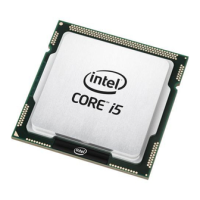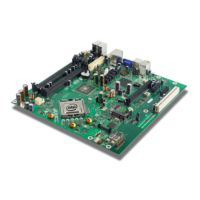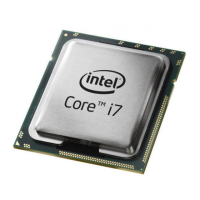Intel
®
Celeron
®
D Processor in the 775-Land LGA Package Thermal Design Guide45
Order #303730
Heatsink Clip Load Metrology
B.6 Test Procedure Examples
The following sections give two examples of load measurement. However, these are not meant to
be used in mechanical shock and vibration testing.
Any mechanical device used along with the heatsink attach mechanism must be included in the test
setup (e.g., backplate, attach to chassis, etc.). Before any test, make sure that the load cell has been
calibrated against known loads, following load cell vendor’s instructions.
B.6.9 Time-Zero, Room Temperature Preload Measurement
1. Preassemble mechanical components on the board as needed before mounting the board on an
appropriate support fixture that replicates the board attach to a target chassis.
For example: A standard ATX board should sit on ATX-compliant standoffs. If the attach
mechanism includes fixtures on the back of the board, those must be included, as the goal of
the test is to measure the load provided by the actual heatsink mechanism.
2. Install the test vehicle in the socket.
3. Assemble the heatsink reworked with the load cells to the board as shown for the Intel
®
RCBFH-3 reference heatsink example in Figure 18 and actuate attach mechanism.
4. Collect continuous load cell data at 1 Hz for the duration of the test. A minimum time to allow
the load cell to settle is generally specified by the load vendors (often three minutes). The time
zero reading should be taken at the end of this settling time.
5. Record the preload measurement (total from all three load cells) at the target time and average
the values over 10 seconds around this target time as well, i.e. in the interval, for example over
[target time – 5 seconds; target time + 5 seconds].
B.6.10 Preload Degradation under Bake Conditions
This section describes an example of testing for potential clip load degradation under bake
conditions.
1. Preheat thermal chamber to target temperature (45 ºC or 85 ºC, for example).
2. Repeat time-zero, room temperature preload measurement.
3. Place unit into preheated thermal chamber for specified time.
4. Record continuous load cell data as follows:
— Sample rate = 0.1 Hz for first three hours.
— Sample rate = 0.01 Hz for the remainder of the bake test.
5. Remove assembly from thermal chamber and set into room temperature conditions.
6. Record continuous load cell data for next 30 minutes at sample rate of 1 Hz.
